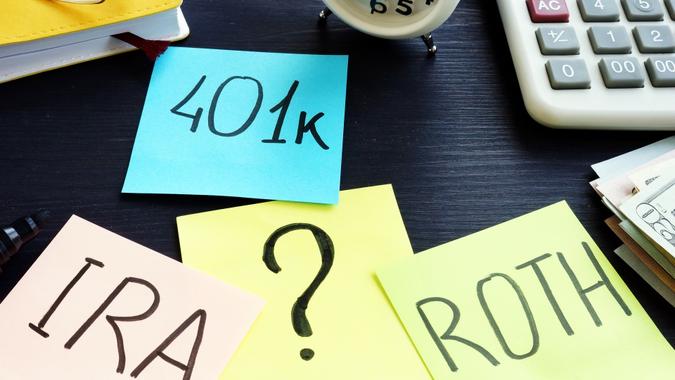
designer491 / iStock.com
If you’ve ever forgotten to roll over your old 401(k) to your new employer, you’re not alone. A recent study found that as of May of 2021, a whopping $1.35 trillion in assets were “forgotten” in old 401(k) plans left behind by employees at their former employers. These accounts, totaling 24.3 million forgotten accounts, have the potential to cost an individual almost $700,000 in lost retirement income savings over the course of a lifetime according to the same study.
See: Should You Be Splitting Your 401(k) Between Traditional and Roth?
Find: Borrow Money From Your 401(k) Due to COVID-19? Here’s How To Pay Yourself Back in a Timely Manner
The administrative logistics of rolling a 401(k) can understandably keep people from consolidating old accounts to one, but following a few basic steps makes it easier.
Regardless of how much, or how little, you make it’s always best to keep your 401(k) in one place. There are two options: roll over your old 401(k) into your new employer’s 401(k) plan or roll your 401(k) into an individual IRA account.
Rolling over a 401(k) to a new employer is fairly straightforward — you simply call the 401(k) provider at your old company and request the rollover yourself or your current employer plan can do it for you.
The other option, which is rolling over a 401(k) into an IRA, is also a popular choice. This move gives you more control over your assets in the long run. There are generally lower fees and more investment options. However, there could be tax consequences, depending on how you do it.
A 401(k) rollover to a traditional IRA account does not cause a taxable event, and your money will still remain tax-deferred. Often, your old 401(k) provider will mail you a check for the full amount of your 401(k) assets. It’s very important that as soon as you receive these funds you forward them along to your IRA provider.
Gaurav Sharma, CEO and co-founder of retirement rollover platform Capitalize says, “Once you’ve got that check, don’t dilly-dally. Just forward it on to your IRA provider. If you don’t know where, quickly check online. If you don’t forward the check on within 60 days then the IRS can deem you to have withdrawn the 401(k) money permanently which could lead to you paying taxes and penalties.”
A 401(k) rollover to a Roth IRA changes the tax treatment of your money, which DOES cause a taxable event. Your 401(k) money is pre-tax, whereas Roth IRA contributions are post-tax, so this conversion will have you adding on the rollover money to your income taxes in the year in which you make the switch.
Chief Investment Adviser of Impact Advisors LLC and CFA Jason Escamilla cautions that you can only do this conversion once and that you’ll need to be aware of income limits to enjoy the full tax benefit.
“If you were between jobs for a while or otherwise in a lower-income / lower tax bracket year, if you do not roll over to the current-company 401(k), you have the option to convert the old plan to a Roth IRA. But you lose this option once you roll over into another 401(k) plan.”
For both options, the name of the game is consolidation. Having all of your 401(k) assets in one place simply makes sense, but it also means you’re not paying fees to 5 different institutions. Whether or not you want to be actively investing in these accounts is up to you, but it’s important to make sure you’re with an institution — and advisor — you feel comfortable speaking with about your retirement investments.
When rolling over assets to a 401(k) or IRA, there are a couple of things to keep in mind. First, no amount is too small. Sharma stresses that even a small 401(k) account can make a big impact.
“A small amount of money today can grow into a sizable sum with the power of long-term investing and compounding, particularly because money in an IRA can grow tax-free. For example, $3,000 in assets today could turn into over $40,000 at retirement if invested appropriately.”
Kenny Senour, a certified financial planner for Millennial Wealth Management, cautions to keep an eye on investment options and their fees. He says, “Your 401(k) plan may have access to a low-cost institutional share class with a high investment minimum. In this example, you may end up paying higher costs for an investment through a higher expense ratio for a comparable investment option in an IRA.”
This means the same investment could be more expensive in a 401(k) than in an IRA.
See: Jaw-Dropping Stats About the State of Retirement in America
Find: Why You Should Invest In a 401(k) at Your First Job
If you’re just starting out, and aren’t sure how to proceed, a target date fund is always a good idea. Sharma says if you’re in doubt and need to make a quick decision, these kinds of funds can be a good starting point.
“It’s basically a low-fee fund offered by companies like Vanguard and Fidelity that has a ‘year’ next to its name representing the year when you’ll approximately retire (e.g. Target Date 2065 fund). The fund automatically buys a mix of stocks and bonds and adjusts it over time,” he says.
While these funds might not be perfect, he adds, they are a good, quick way to get you started while you take a step back to think about what you really want to invest in.
More From GOBankingRates